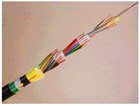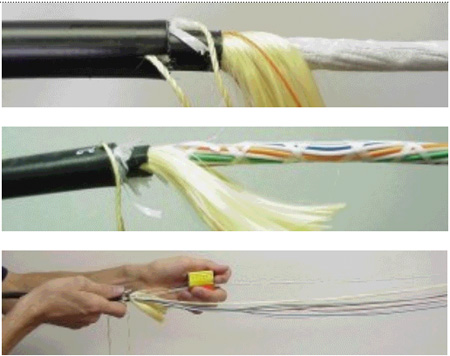White Paper: Innovative cable design enables fiber-to-the-curb delivery

By Jonathan Fitz, Pirelli Cables & Systems
Cable design
Enclosure design
Installation
Optical fiber is now widely deployed in almost every type of high-speed network. However, an optical-to-electrical (O/E) conversion of the signal is necessary for most end-users' equipment. The point at which this conversion takes place is a key variable in the price, performance, and reliability of a network.
Insatiable bandwidth demand has pushed fiber ever-further into the network. Although many envision fiber-to-the-home (FTTH) as the logical conclusion of this progression, equipment costs remain a significant barrier to constructing such networks. Yet, performance and reliability requirements favor making O/E conversions as close to the end user as possible. Fiber-to-the-curb (FTTC) is a good compromise between these competing objectives.
However, FTTC networks introduce new challenges of their own. The O/E conversion units (often referred to as optical network units or ONUs in this context) must be electrically powered. This can be very inconvenient for two reasons. First, it isn't practical to power these devices from the end-user's home. But, it is even more complicated to provide individual power utility taps for such a large number of widely dispersed converters.
Luckily, the power requirements for most ONUs are fairly small. These devices can be remotely powered via compact power cables. This allows the network designer to avoid the expense of large power cables or numerous power taps.
The main challenge when installing FTTC systems, then, is supplying the power without making the network too complex. If installation labor is substantially increased, the total network cost may approach FTTH, without the added benefits. Electrical conductors must be added to the network in such a way that there is little effect on the cost or complexity of network installation.
A variety of cable designs have been developed to address this need. Each design has something to offer, but has focused on a particular area of labor savings. Pirelli Cable has developed a new design, called CurbLink, which combines the benefits of previous designs with altogether new features. This new design significantly reduces installation labor while increasing the range of applicable deployment scenarios.
CurbLink incorporates both copper conductors and optical fibers in a single cable. This allows both data and power to be supplied from a single reel in a single cable pull. All cable elements are housed within a single sheathing system, thus reducing sheath access time (see Figure 1).

The copper conductors are 19 AWG, which is the largest of the standard telephony gauges. This allows longer distances between the ONU and the power supply while maintaining compatibility with tools and connectors which are already in use. The conductors are untwisted, which improves flexibility and cost by reducing the diameter of the cable. Each conductor is uniquely identified by an insulation color that does not repeat within the cable. The conductors are helically stranded with a reverse-oscillating lay. This allows extra conductor length to be wound off when the cable must be accessed in a taut-sheath setting. Conductor counts of 5, 13, and 24 pairs are available.
Aramid yarns provide high tensile strength while preserving flexibility and minimizing cable size. These yarns are also craft friendly since they are safe to handle and easy to secure. Dry, water-blocking tapes are used prevent water ingress without sticky waxes, which impede personnel and are difficult to remove.
Fibers are housed within a centrally located, filled, loose tube. The tube is highly flexible and can be installed in a variety of enclosures without the need for express tubing. The tube can also be accessed with a slitter for mid-span, taut-sheath splices. Fiber counts of 2, 6, and 12 fibers are available.
Enclosure design
Enclosures have also been designed to make the best use of these new designs. Copper and fiber splices are separately managed and neatly organized within the enclosure. Aerial enclosures are designed to allow easy mid-span, taut-sheath access at any point along a span (see Figure 2).

The grommets are self-sizing and can be placed over the cable without cutting the grommets, the cable, or using any special tools. The clamps are strong enough to meet Bellcore pullout requirement, and can quickly be installed mid-span without special tools.
The fiber splices are mounted on the front of the panel, while electrical splices are moved to the rear. The panel is shaped so that the distribution cable can pass straight through, with the buffer tube protected by a recess in the panel. All cable subcomponents are held in place with reusable clips.
An aerial strand supports the enclosure. Pedestal type enclosures are also available for buried applications.
The cable is designed for use in drop and local distribution applications. The design saves labor both during initial installation and whenever additional service is needed. This range of application is made possible by two key factors: 1) the cable is available with a wide range of fiber and conductor counts; and 2) it can easily be accessed at almost any point and at any time. The combination of these factors produces tremendous synergy.
One example of this benefit is the ease with which multiple ONUs can be installed on a single drop cable. A drop can be pre-connectorized and installed with only one ONU. However, it is fairly inexpensive to install extra fibers without connectors. As demand grows, additional ONUs can be added onto the drop where and when they are needed. No additional cable pulls are needed to support new customers. The same principal can be applied to the local distribution cable, where it is possible to add new drops as demand requires. Thus, labor savings are realized during initial installation and during the inevitable expansion of the network.
The easy access is facilitated by the cable's construction. As an example, consider what is typically the worst-case for accessing a cable—mid-span and taut-sheath. The cable cannot be cut and there is little or no slack to work with.
The access steps are illustrated below. The enclosure is left out for clarity. Keep in mind that the enclosure can be added on at almost any point to suit the installer's preference. The jacket is removed with standard craft tools and techniques. The yarns, tape and binders are then cut and set aside to expose the conductors. The conductors are wound off and can be moved to one side due to the extra length imparted by the reverse oscillating lay. A tube slitter can then be used to access fibers within the buffer tube (see Figure 3).

Fiber-to-the-curb can be an effective network strategy if the challenges of ONU powering can be cost-effectively overcome. CurbLink cables address these challenges in a compact, craft-friendly design. A wide range of conductor and fiber counts is available, in addition to enclosures that are optimized for this application. This system approach simplifies initial installation and also facilitates future network expansion.
About the author…
Jonathan (Jon) Fitz is a product development manager with Pirelli Cables & Systems LLC, Lexington, SC.
